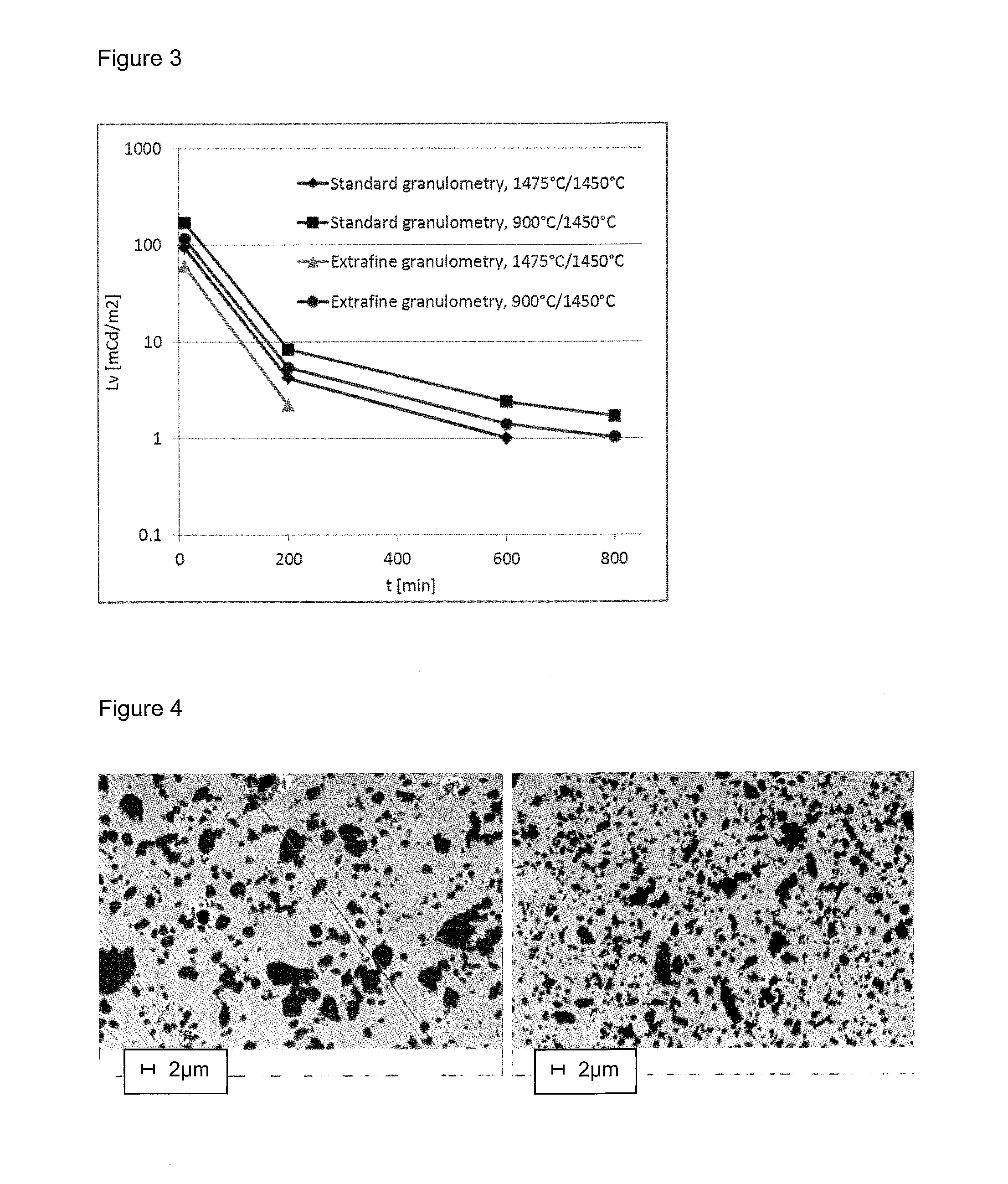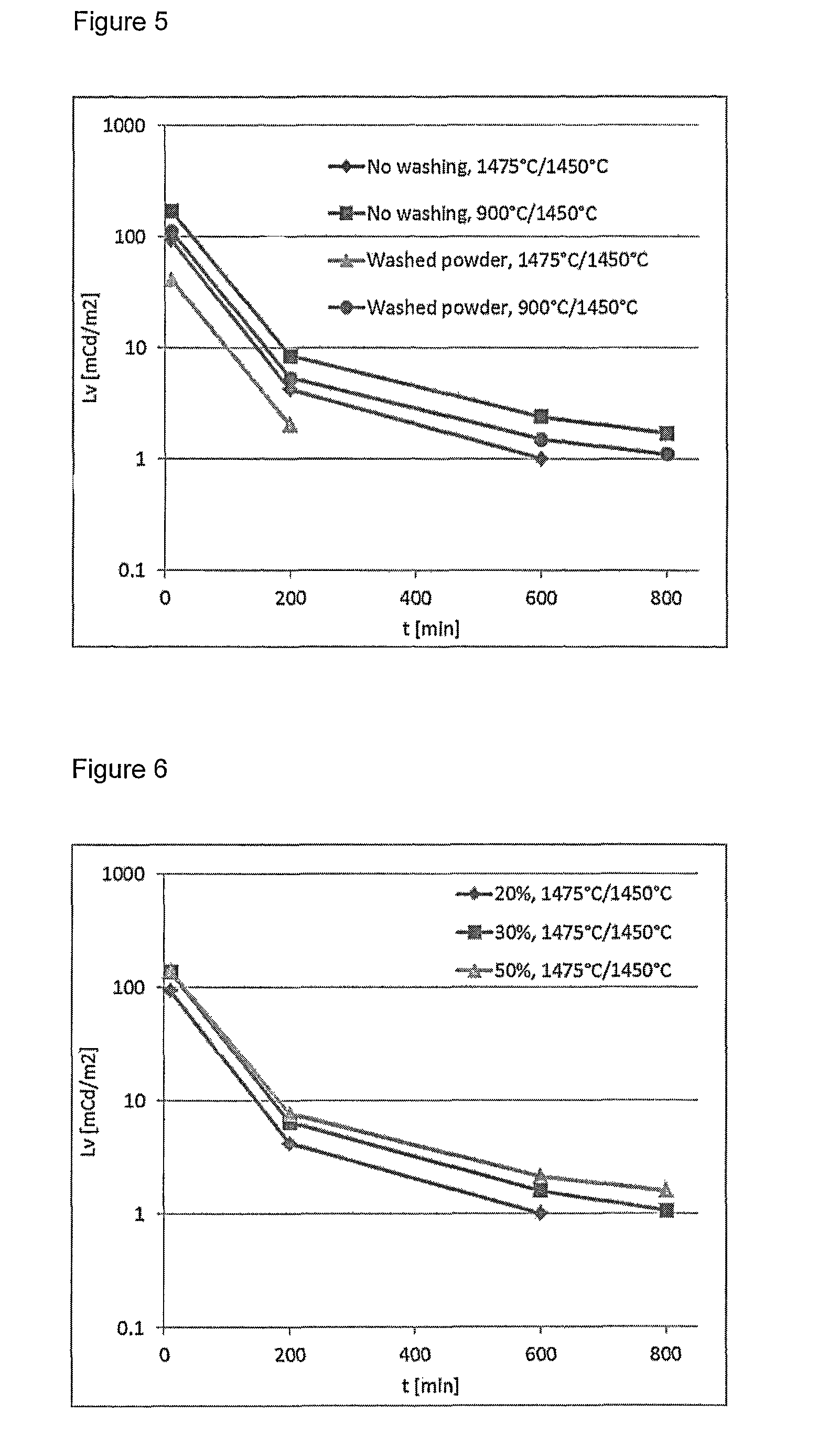Persistent phosphorescent composite material
a composite material and persistent technology, applied in the field of ceramic composite materials, can solve the problems of zrosub>2 /sub>crack upon cooling, and achieve the effect of interesting properties in terms of persistence and perceived intensity
- Summary
- Abstract
- Description
- Claims
- Application Information
AI Technical Summary
Benefits of technology
Problems solved by technology
Method used
Image
Examples
example 1
[0078]A sample 1 containing 20 wt % of phosphor has been prepared as follows:[0079]Mixing 80.0 g of zirconia powder containing 3 mol % of yttria (TZ-3YS obtained from TOSOH Corporation) and 20.0 g of Sr4Al14O25: Eu,Dy powder with 3.0 g of organic binder composed of 1.2 g (40%) PVA and 1.8 g (60%) PEG 20 000 in solution at 50% in water, with 200 ml distilled water and 1 kg of zirconia balls;[0080]Attrition / milling at 400 U / min during 30 min in a zirconia bowl;[0081]Filtering of the suspension, rinsing of the balls and bowl with 450 ml IPA, spray-drying of the filtered suspension and rinsing liquid.
[0082]7 g of powder were then pressed in a φ40 mm mould. During a first heat treatment, debinding and sintering were performed in one step in a furnace under ambient atmosphere, at 1475° C., with a soak-time of 2 h with 21 h ramp-up time and 11 h cooling time (total treatment time of 34 h).
[0083]The obtained pellets were machined and polished. The typical density as measured by the Archimed...
example 2
Effect of the Strontium Aluminate Phase
[0085]The potential of two different strontium aluminates with rare-earth (RE) dopants to obtain a persistent phosphorescent ceramic material that is suitable, e.g., for watch applications was investigated.
[0086]Two phases showed suitable performances for such applications: the Eu2+ / Dy3+ doped SrAl2O4 phase which emits around 520 nm (green) and the less used Eu2+ / Dy3+ doped Sr4Al14O25 phase which emits around 495 nm (blue). Although the green-emitting phase is most widely used, the blue-emitting material shows very interesting properties in terms of persistence and perceived intensity.
[0087]Two samples with 20% by weight of active SrAlO material were prepared in the manner as described in example 1, with a pre-sintering performed at 900° C. under air and a sintering in reducing atmosphere at 1450° C. for 3 h (sample 2.1 incorporating the green-emission SrAl2O4 material and sample 2.2 incorporating the blue-emission Sr4Al14O25 material). The res...
example 3
Influence of Sr4Al14O25 Grain Size and Sintering Conditions
[0090]The influence of the grain size of the initial phosphor material on the obtained performances was studied for two different sintering conditions.
[0091]The images in FIG. 2 show the microstructures of the samples with standard granulometry (DV10=1.2μm; DV50=2.5 μm; DV90=6.4 μm, as in the samples 3.1 and 3.2, at left) and so-called “extra-fine” granulometry (DV10=0.1 μm; DV50=1.4 μm, DV90=4.7 μm, as in the samples 3.3 and 3.4, at right).
[0092]The behaviour of the four samples is displayed in table 2 and FIG. 3.
[0093]
TABLE 2SrxAlyOzphasesZrO2 phases(Sr4Al14O25 / (tetragonal / Pre-ColourDensitySrAl2O4 / cubic / samplesinteringsintering(LAB)(g · cm−3)SrAl12O19)monoclinic)3.11475° C. in1450° C. in94.8 / −2.5 / 5.3320 / 0 / 056 / 23 / 1airN2 / H2, 4 h4.13.2900° C. in1450° C. in95.7 / −3.5 / 5.3320 / 0 / 056 / 23 / 1airN2 / H2, 3 h6.33.31475° C. in1450° C. in94.6 / −2.2 / 5.3518 / 0 / 060 / 21 / 1airN2 / H2, 4 h3.23.4900° C. in1450° C. in95 / −3 / 55.3518 / 0 / 060 / 21 / 1airN2 / H2, 3 h
[...
PUM
| Property | Measurement | Unit |
|---|---|---|
| sintering | aaaaa | aaaaa |
| sintering | aaaaa | aaaaa |
| density | aaaaa | aaaaa |
Abstract
Description
Claims
Application Information
 Login to View More
Login to View More - R&D
- Intellectual Property
- Life Sciences
- Materials
- Tech Scout
- Unparalleled Data Quality
- Higher Quality Content
- 60% Fewer Hallucinations
Browse by: Latest US Patents, China's latest patents, Technical Efficacy Thesaurus, Application Domain, Technology Topic, Popular Technical Reports.
© 2025 PatSnap. All rights reserved.Legal|Privacy policy|Modern Slavery Act Transparency Statement|Sitemap|About US| Contact US: help@patsnap.com



